German Shepherds, like other canines, aren’t endowed with verbal communication.
As such, they must tell you what they feel and experience through body language, including positioning and wagging their tail. So, what do German Shepherds’ tail positions mean?
Here are 13 German Shepherd tail positions and what they mean:
- Tail raised high – alert and excited.
- Tail hanging down – troubled and submissive.
- Tail straight out – exploring and undecided.
- Tail low and wagging left – concerned or unhappy.
- Tail semi-raised and wagging right – happy.
- Tail raised and wagging fast – excited.
- Tail low and wagging slowly – lack of enthusiasm.
- Tail wagging with up and down broad strokes – very happy.
- Tail wagging in half-mast short strokes – anxious.
- Tail carried in a neutral position – relaxed.
- Tail loose and wiggly – happy.
- Tail held high and stiff – aroused and confident.
- Tail tucked between the legs – afraid.
This article will explore these different tail positions in more detail so you can get to know your dog a little better. Let’s dive right in!
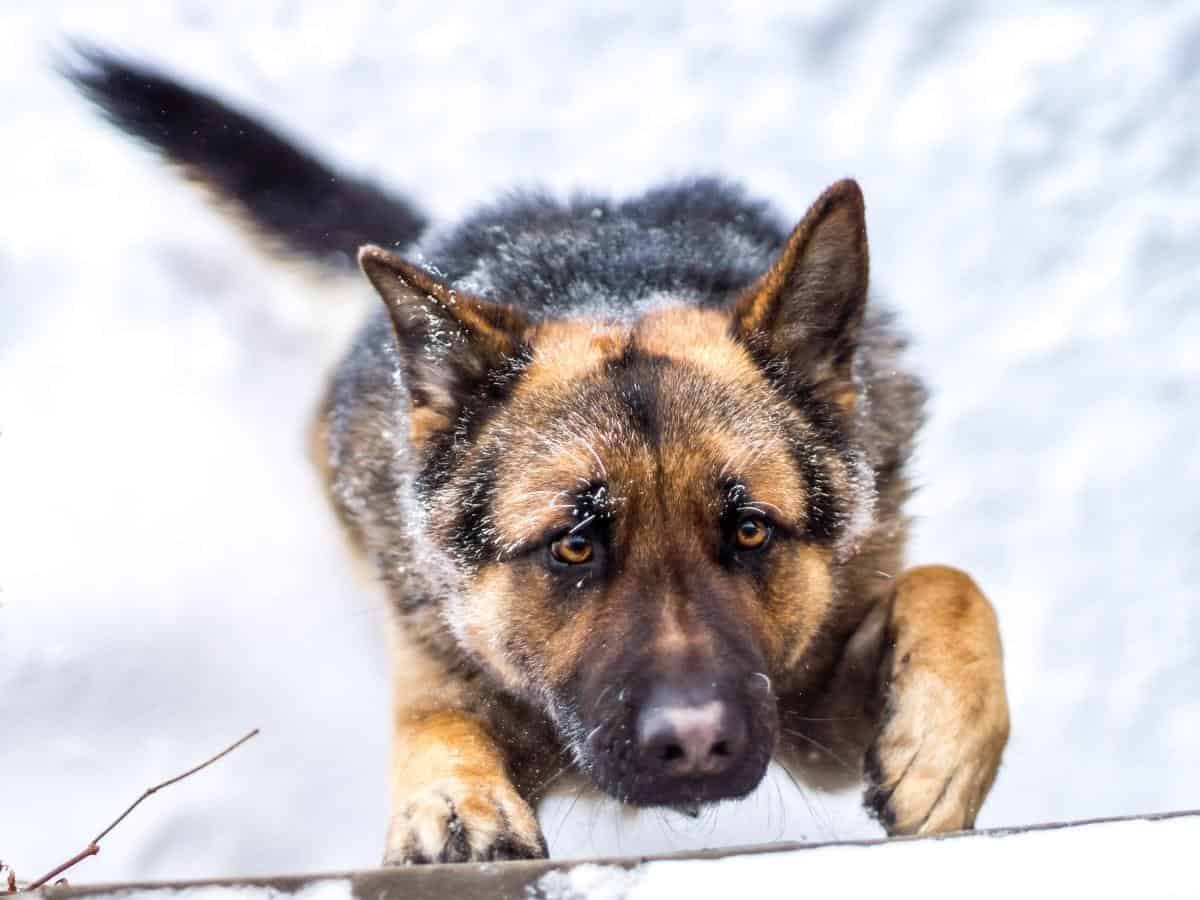
What Do German Shepherd’s Tail Positions Mean?
The German Shepherd is quite creative at using its tail to communicate. For that reason, you’ll notice your dog’s tail in various positions and movements.
German Shepherds’ tail positions can mean anything from excited and alert to fearful and submissive. It may be in a neutral, straight out, high, or half-mast position to convey arousal, relaxation, or anxiousness and can vary in meaning when accompanied by a fast or slow wag.
To help you understand these German Shepherd tail positions, let’s discuss the tell-tail signs of each at length. Or, if you prefer, you can watch our video below…
1. Tail Raised High – Alert and Excited
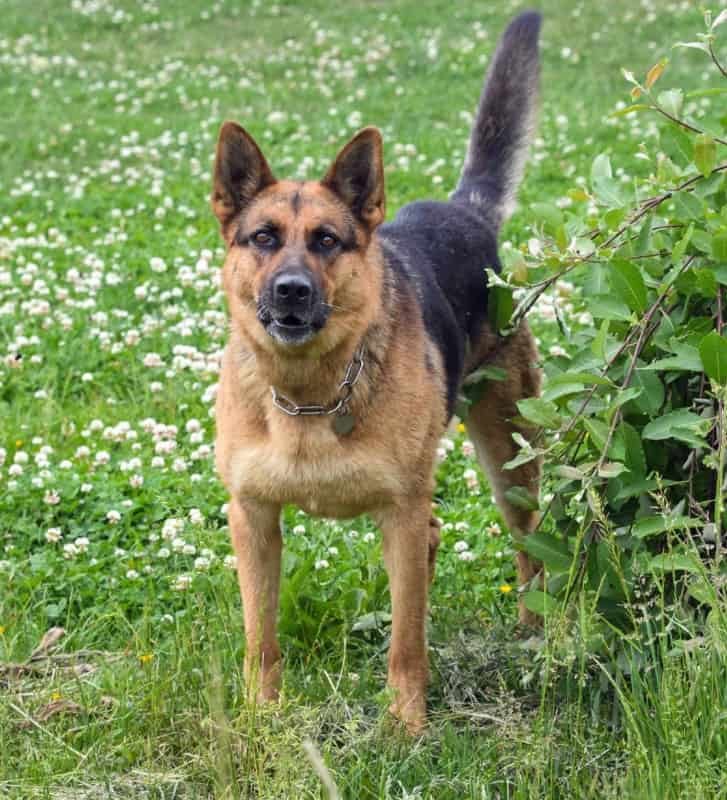
A German Shepherd with a tail raised high is alert and excited.
A raised tail often comes with erect ears, which could be a sign that:
- The dog is ready to run and attack.
- The dog may make a move to face whatever is calling their attention.
- The dog may make a display of dominance.
This is especially true if the raised tail is accompanied by very fast tail wagging, which appears to be vibrating.
Stay alert when your German Shepherd has its tail raised high and vibrating, as you may need to leash or crate them.
2. Tail Hanging Down – Troubled and Submissive
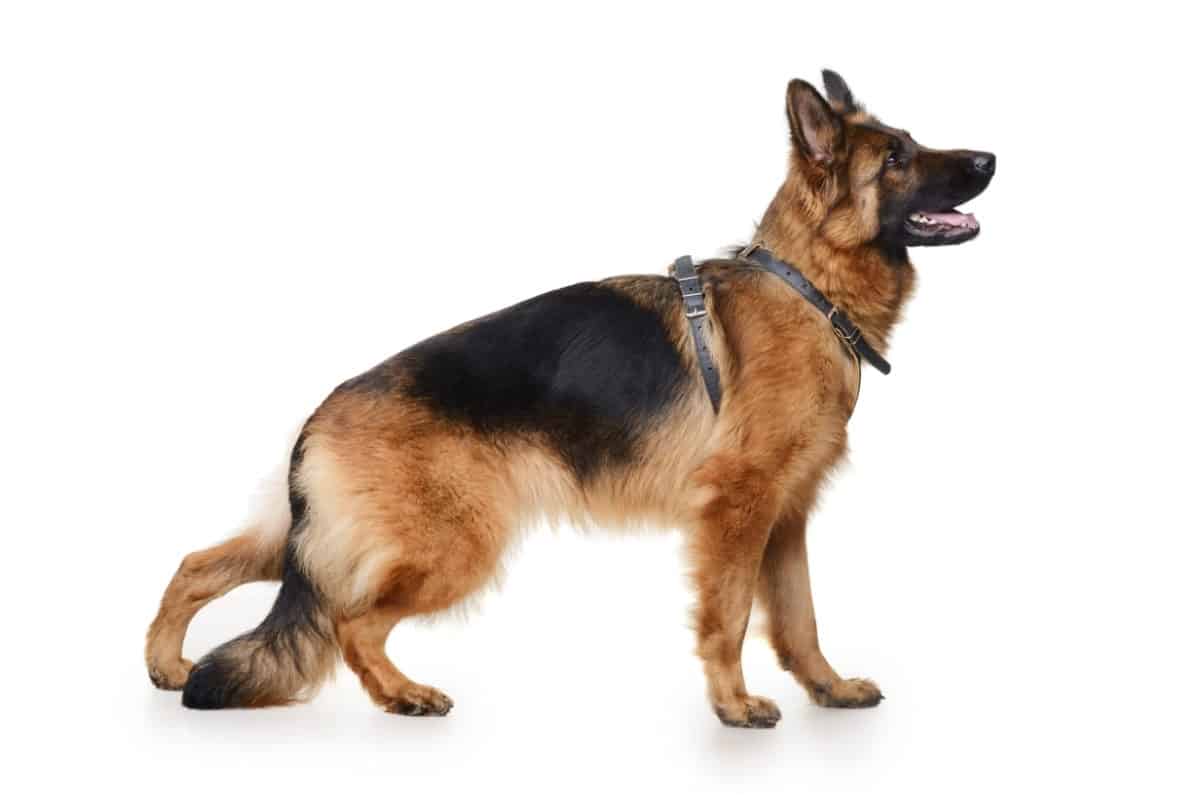
When your German Shepherd has its tail hanging down (not between the legs), chances are they’re troubled and submissive.
Your dog might have done something it knows you’re angry about and isn’t sure what action you’ll take. By carrying its tail in submission, it communicates that it’s aware you have the last word.
If a slight wiggle or wag is added, your dog communicates appeasement.
3. Tail Straight Out – Exploring and Undecided
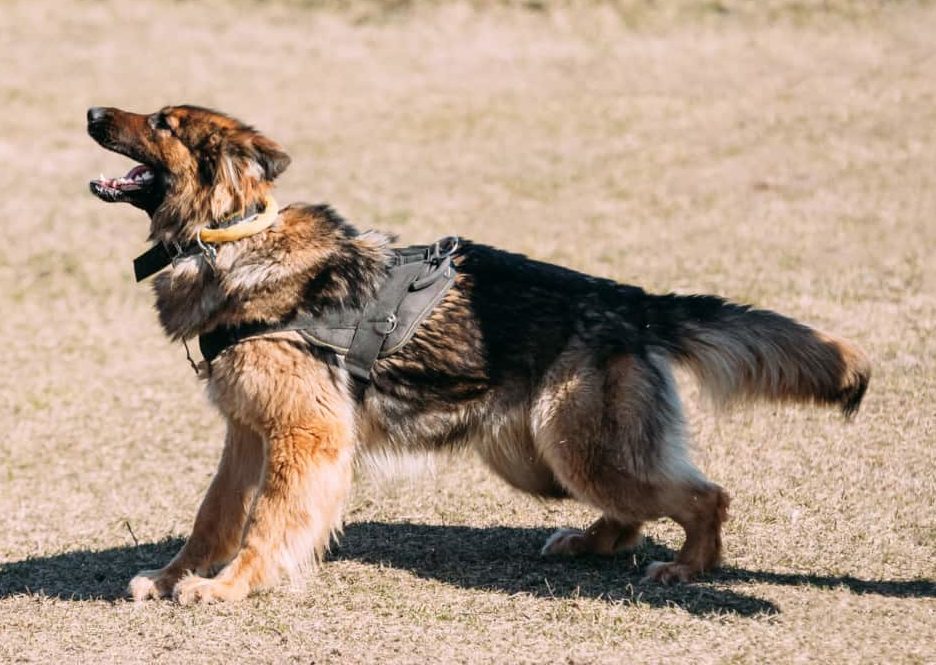
A German Shepherd with the tail straight out is exploring the situation and is undecided. The dog could be meeting someone new – a person or dog – and is unsure what action to take.
Your GSD could also be hearing noises whose meaning and origin they have yet to figure out. So when you see your German Shepherd with its tail straight out, just give it time to figure things out.
4. Tail Low and Wagging Left – Concerned or Unhappy
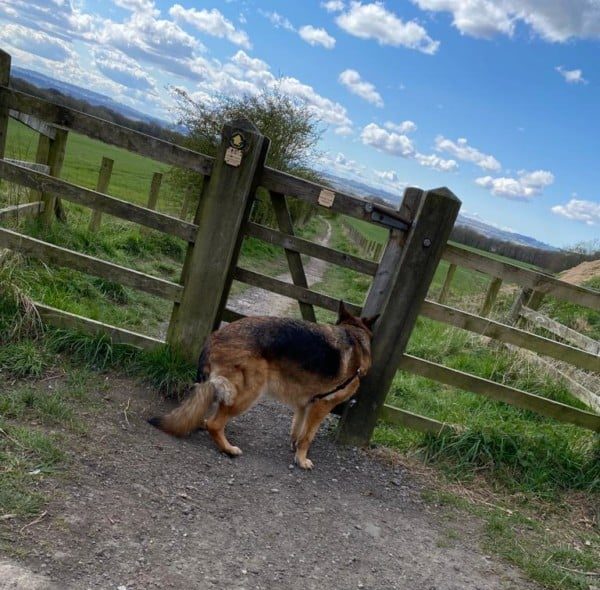
As with the right side tail wagging (which we’ll cover below), a German Shepherd’s tail wagging to the left is controlled by brain action, this time the right side of the brain.
When your German Shepherd wags its tail to the left, it’s having an unhappy experience with someone or another animal. It could be that your GSD has spotted a dominant strange dog, a human, or another animal they don’t like.
In the above photo, my German Shepherd is unhappy that she can’t get through the gate. She has seen some deer in the field, and her prey drive has kicked in!
According to this study, your dog could also be observing another dog wagging its tail to the left, suggesting it’s conscious of a negative experience being communicated by the other dog.
5. Tail Semi-Raised and Wagging Right – Happy
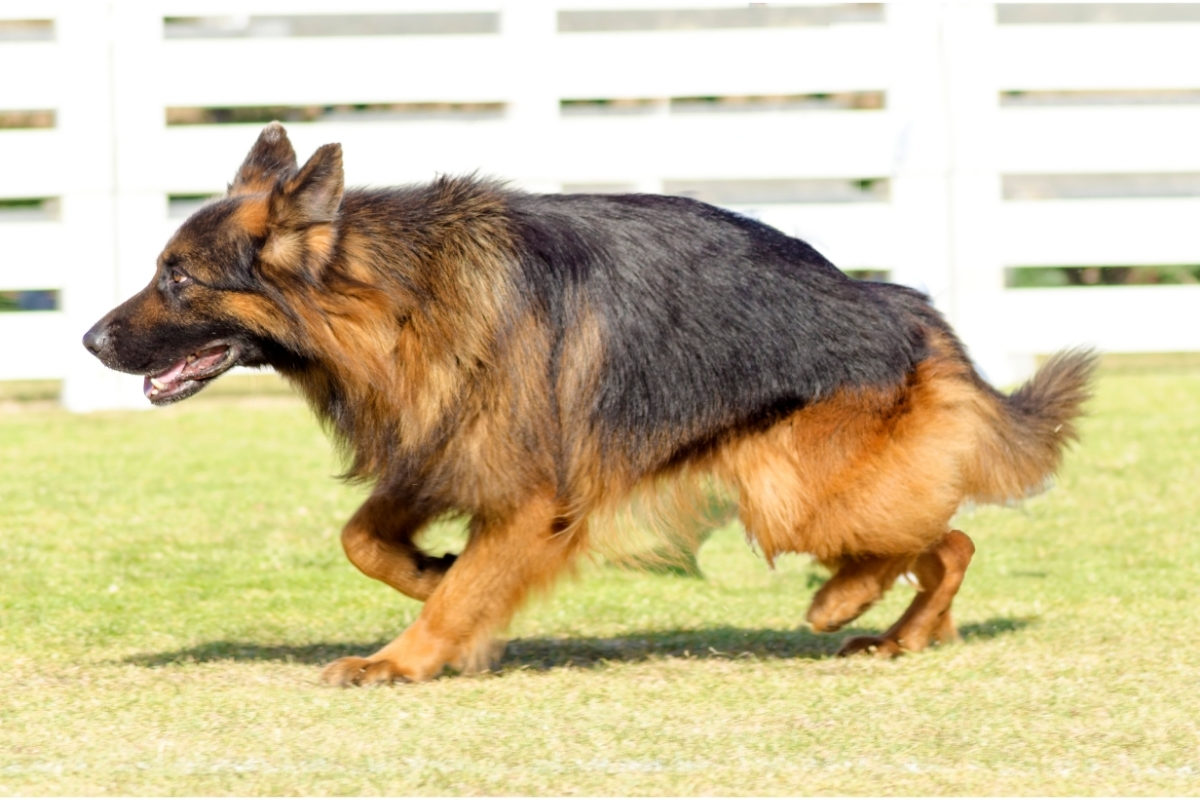
Your German Shepherd’s tail wagging is controlled by brain action. Research has shown that dogs tend to wag their tails to the right when happy, and the left side of the brain directs this tail movement.
If your German Shepherd’s tail is semi-raised and wagging right, it’s happy with you or the situation. In fact, the mentioned research found that dogs wagged their tails to the right at the sight of their owner.
6. Tail Raised and Wagging Fast – Excited
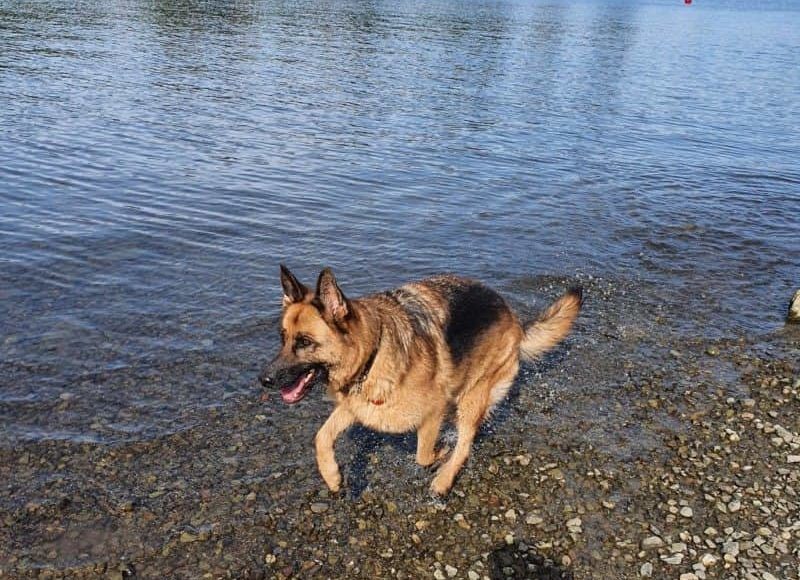
If your German Shepherd has the tail raised and wagging fast, it’s friendly and excited.
It could be the joy of seeing you home again after work of seeing you present his favorite food or toy, or when you arrive at a new place, and the excitement just takes over.
The above image of my German Shepherd shows her excitement running at the edge of Lake Windermere in the Lake District, Cumbria, UK.
However, your German Shepherd can show a fast wagging tail when anxious and ready for action in tense situations.
7. Tail Low and Wagging Slowly – Lack of Enthusiasm
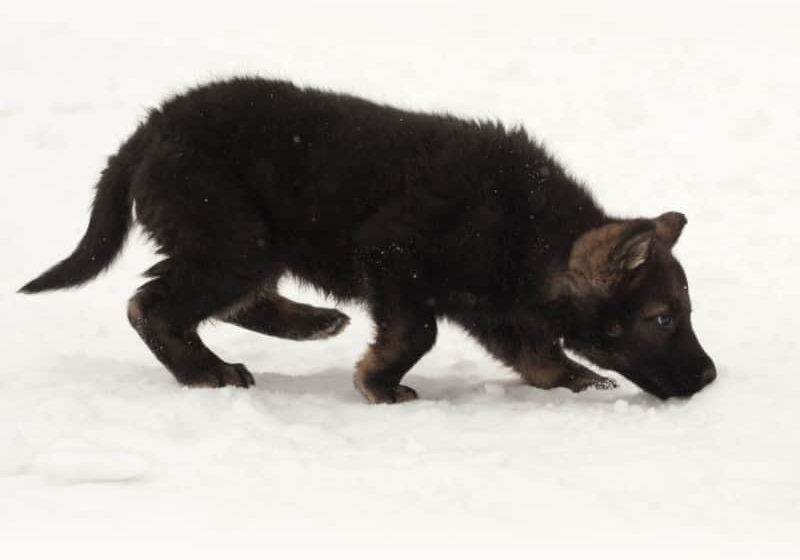
When your German Shepherd has its tail hanging or half hanging and wagging slowly, it’s not enthusiastic or excited about the prevailing situation.
In an everyday life situation, it could be that:
- The German Shepherd isn’t happy with someone or something unfamiliar to them and is hesitant to show their approval or be friendly.
- The German Shepherd is meeting a strange dog and is unsure what role to take with the new conspecific.
Either way, you should remove your German Shepherd from the uncomfortable situation.
8. Tail Wagging With Up and Down Broad Strokes – Very Happy
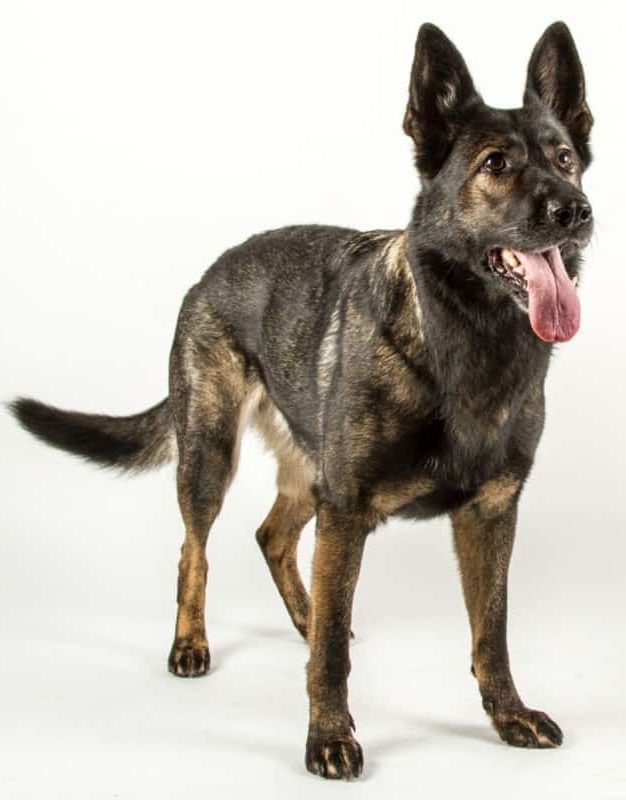
If your German Shepherd is wagging its tail up and down in broad strokes, your dog is extremely happy. You’ll likely see this when you arrive home from work.
In this case, your German Shepherd will also accompany the tail wagging with other body signs of happiness like:
- A relaxed shaking of the entire body.
- A grin on its face.
- A soft, open mouth.
9. Tail Wagging in Half-Mast Short Strokes – Anxious
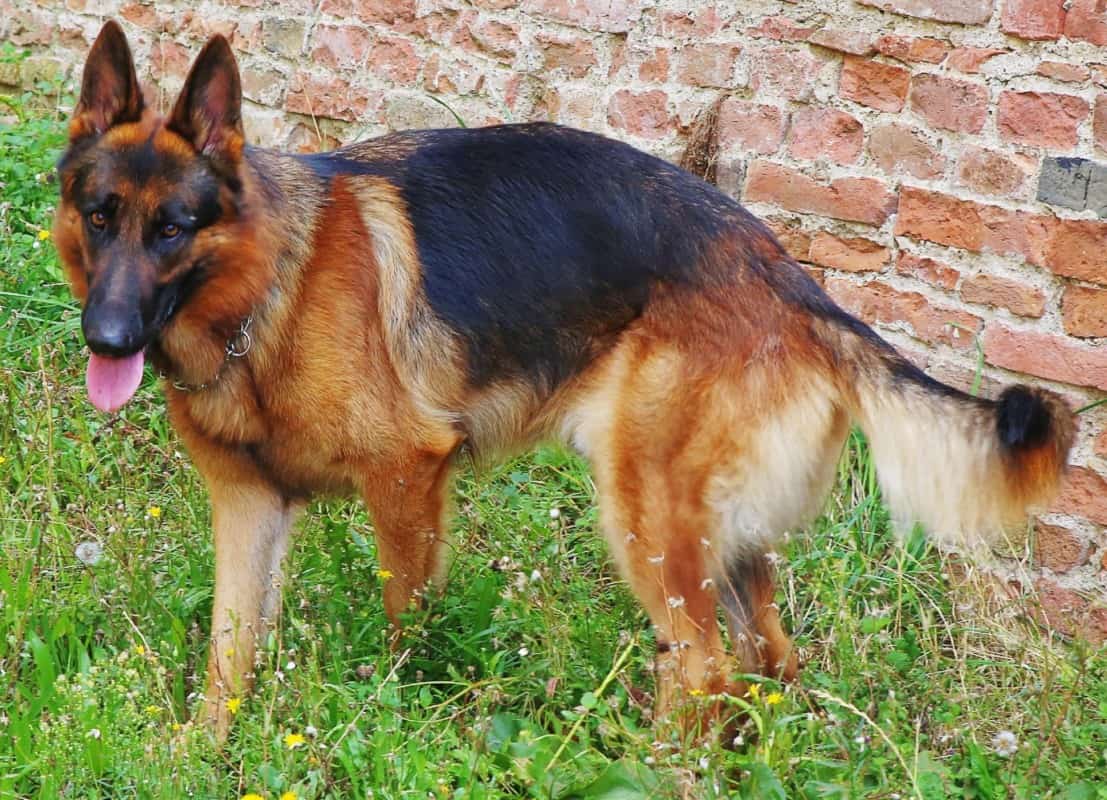
If your German Shepherd wags its tail in midway short strokes, it’s tense and anxious. Your dog could also be showing a lack of enthusiasm and insecurity.
If the half-mast short strokes are swift, your dog could simply be greeting and feeling tentative or hesitant about a move.
10. Tail Carried in a Neutral Position – Relaxed
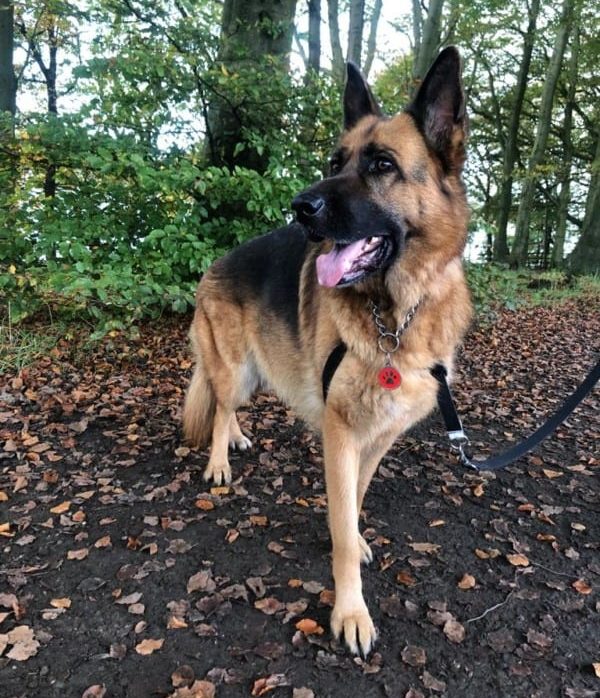
If your German Shepherd’s tail is in a neutral or natural position, your dog is relaxed or simply living the experience of being loved and at peace with the surroundings.
Check out Willow in the above photo. Her tail is relaxed in its neutral position; she is undoubtedly chilled, and she loves being in the woods.
If the dog is relaxed and feeling extra happy, they may add a little wag to their loose tail.
11. Tail Loose and Wiggly – Happy
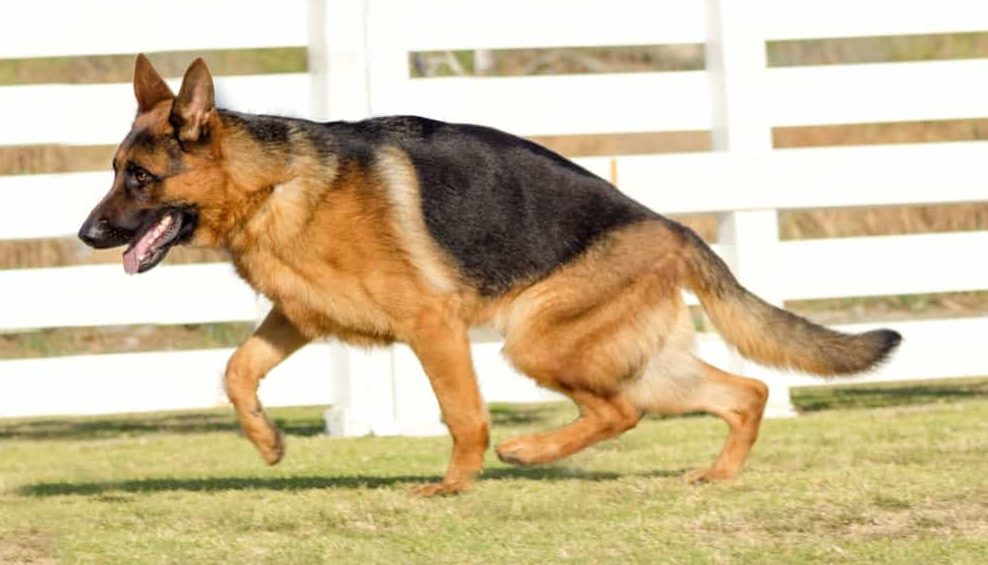
When your German Shepherd has a loose and wiggly tail, it’s a sign your dog is happy. They may accentuate that with a side-to-side wag or in circular motion wags.
Your German Shepherd will also have a loose and wiggly tail when the environment is relaxed, and if a gaze towards you accompanies that, they most likely want to play.
12. Tail Held High and Stiff – Aroused and Confident
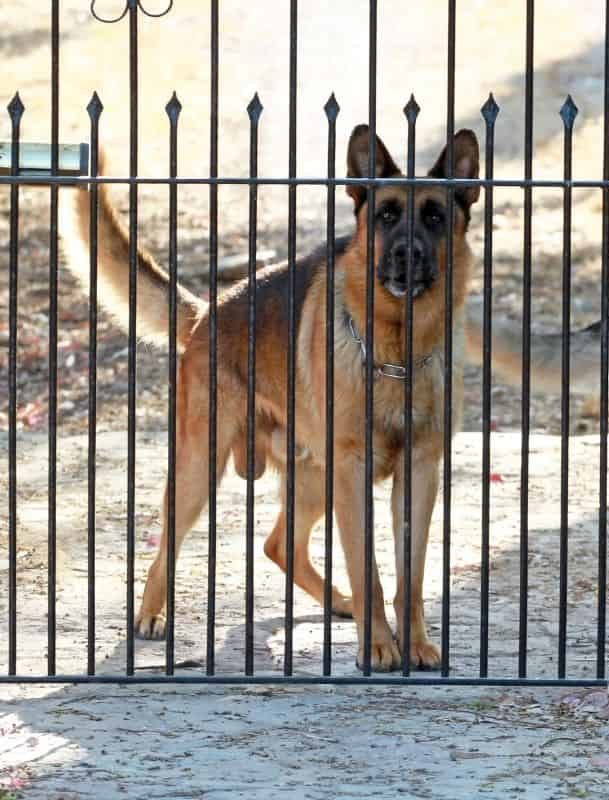
If your German Shepherd has the tail held high and stiff, your dog is aroused and feeling confident. However, if they’re around other dogs, a high and stiff tail could show dominance.
Pay particular attention to your German Shepherd if it has a high and stiff tail combined with raised hackles, a wrinkled nose, and an open mouth with visible teeth.
Together, these signs could warn other dogs or strangers to back off. Your German Shepherd may be about to get aggressive.
13. Tail Tucked Between the Legs – Afraid
A German Shepherd’s tail tucked between the legs is the typical tail position when your dog is afraid, scared, or uncomfortable. For example, your dog could be in pain or encountering someone or something that instills fear.
A German Shepherd’s tail between the legs could signify submission and fear of imminent punishment.
You’ll likewise notice this German Shepherd’s tail position if they get involved in a fight with another dog, lose the battle, and have to run for their life.
Watch How To Interpret Dog Tail Wags In This Video…
The Unique Characteristics of German Shepherd Tails
When describing the appearance of a German Shepherd’s tail, we need to look at the AKC official standard of the breed:
A purebred German Shepherd has a bushy tail, with the last of the interlocking bones of the tail extending to the hock joint. The tail should be set smoothly into the croup or the rear end where the pelvis bone is and where the tail attaches to the rump.
Your German Shepherd’s tail hangs in a slight curve when resting, similar to the saber. The tail is raised in motion, and the saber curve is emphasized but not beyond a vertical line.
As you can understand from the description, a German Shepherd’s tail is one of the most prominent parts of its body. That makes it easy to see the tail when you want to decipher the message that your German Shepherd is communicating with its tail position.
FAQs
Why Does My German Shepherd’s Tail Curl?
A German Shepherd’s tail can curl due to one of these reasons – genetic trait, medical condition, and anxiety. Checking their bloodline and paying attention to their medical condition will help you understand it better.
Can a German Shepherd’s Tail Position Change Based On Its mood or Environment?
Yes, it’s more likely. For example, if they feel happy or excited, their tail may be held high and wagging vigorously. On the other hand, if they are feeling scared or anxious, their tail may be tucked between their legs.
Additionally, if they are in a new or unfamiliar environment, their tails may be lower as they assess their surroundings.
Final Thoughts
Observant German Shepherd owners and enthusiasts have, no doubt, noticed some German Shepherd tail positions they found hard to decode. As a result, many have asked the question: what do German Shepherds’ tail positions mean?
As you know, the tail’s position could mean anything from fear to arousal.
While you’ll read many messages from the tail position, it’s essential to observe your dog broadly.
Tail positions are often accompanied by wagging and other body language like posture, facial expressions, and body movements. So remember to look at everything as a whole.
Related Posts You May Like:





